|
One of the first companies in the town to have large
workshops was S & R Carter of King's Hill Works, which
was located off Birmingham Street, on a site later
occupied by Darlaston Tram Depot. |
|
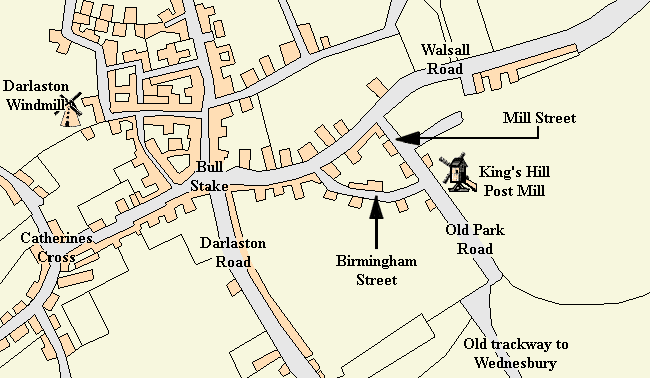
The area around Birmingham Street
in the 1830s. Based on the OS map from the 1831 to 1838
series. |
|
In 1841, brothers Simeon and Reuben Carter
were both coach smiths, Simeon living in Eldon Street,
and Reuben in Darlaston Road. By 1842 they had started a
manufacturing business, as can be seen from the
following entry in the
Wednesbury section of Pigot & Company's 1842 Directory:
Simeon Carter was baptised at St. Lawrence's Church,
Darlaston on the 25th January, 1818. He was the son of
James and Lucy Carter who came to Darlaston in about
1800. His brother, Reuben, was born on the 9th February,
1816. Simeon married Ann Jones, daughter of John and
Lucy Jones, at All Saint's Church, West Bromwich on the
31st December, 1840. Reuben married Martha Bayley,
daughter of Samuel and Mary Bayley, at St. Matthew's
Church, Walsall on the 19th April, 1836.
Both families were keen Methodists and attended
Pinfold Street Wesleyan Methodist Chapel and Darlaston
Green Methodist Chapel.
The brothers acquired a house, workshop and yard on
683 square metres of land alongside a small alley on
the western side of Birmingham Street (then known as
King’s Hill Road), roughly on the site of Corns Street.
It can be seen on the 1846 Wednesbury tithe map. By 1851
the brothers and their families were living in two
adjacent houses on the northern side of the Black Horse
pub, in what is now called Old Park Road.
|
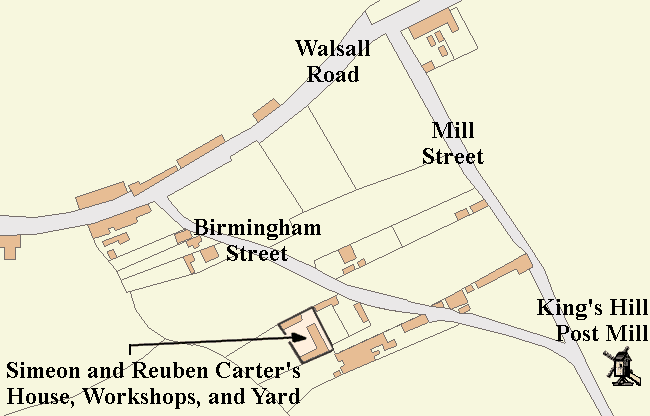
Simeon and Reuben Carter's site.
Based on the 1846 Wednesbury Tithe Map. |
|

A directory entry from
1850. |
In the 1851 census the brothers are described as
master smiths employing seven men. The census lists two
apprentices at Reuben Carter’s house, and another at
Simeon’s House, who were presumably employees. They were
William Cooper, Henry Mansey, and Isaac Ennes. The firm
is
listed in Kelly’s Directory for that year as railway
carriage and coach smiths, manufacturing railway
carriage and coach bolts, draw links, steps and brakes,
buffer rods, and ironwork of every description.
|

Slater's Classified
Directory, 1851. |
|

From WilliamWhite's
1851 History, Gazetteer and Directory of
Staffordshire. |
By 1860 the business had grown. It
is listed in the 1860 Kelly’s Directory as S & R Carter,
King’s Hill Works, contractors and manufacturers of iron
bridges, girders, tanks, boilers, wrought iron roofs,
fastenings and every description of railway ironwork. To
produce these products, the firm would have required
more and larger workshops, more staff, and more space.
It is likely that some of the empty surrounding land was
acquired from the owner, James Corns.
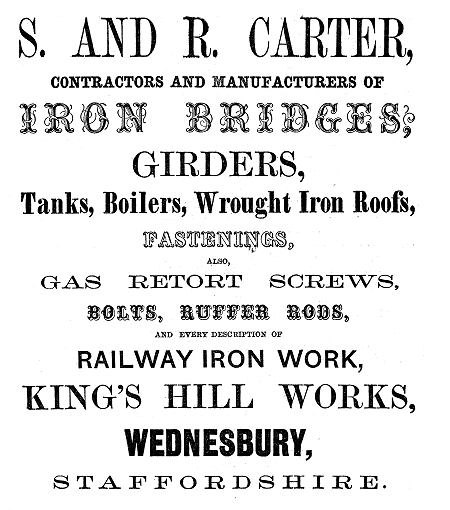
From Harrison, Harrod & Company's
Directory & Gazetteer of Staffordshire, published in
1861. |
In the 1861 census the brothers are listed
as railway iron manufacturers. By this time
their three eldest sons also worked in the
business. In 1862 building work began on the
London & North Western Railway’s Darlaston
Branch, which opened on 1st September, 1863. It
ran from a junction on the main line at James
Bridge, through Darlaston town centre, to a
junction close to Wednesbury Town Station, on
the line from Walsall to Dudley. It included
Darlaston Town Station, situated in the cutting
between Walsall Road, and Darlaston Road.
The railway, which ran close to King’s Hill
Works, included a siding that ran directly to
the factory. It must have been extremely useful
to the firm. Large amounts of goods were
transported by the railway company, both day and night, serving many
factories along the route. |
|

From Jones's 1865
Commercial Directory. |
By this time Simeon Carter was
running the business alone, because Reuben died on 27th
March, 1863 at the early age of 47. The firm now
employed a considerable number of people. An article
appeared in the Worcestershire Chronicle on 17th August,
1864 that described a works’ outing to Malvern. Around
three hundred people enjoyed their day out, which had
been paid-for by the management. The group would have
included not only employees, but also close family
members, as well as a band of musicians from Bilston.
The large number of employees gives an indication of the scale of the operation at the
factory. |
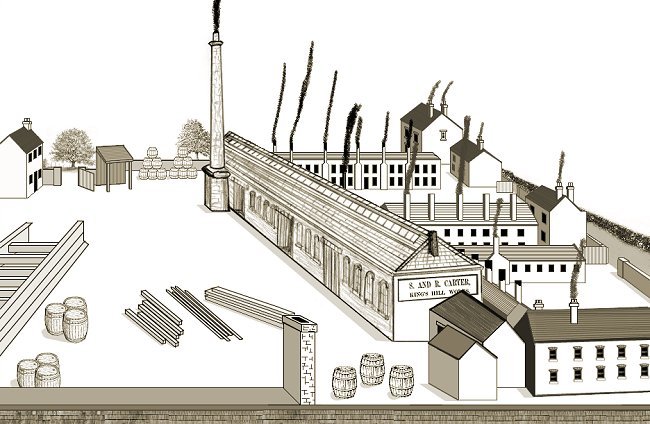
An impression of how King's
Hill Works may have looked in the 1860s. It is based
on a poor copy of a photograph of an etching that is
believed to be of the factory. Unfortunately the
original seems to have been lost. This view is
looking eastwards towards Birmingham Street. I have
to thank Peter Carter for the original image. |
| At the beginning of 1866 the future looked bright, but
things rapidly went wrong. The firm was a customer of the
Birmingham Banking Company, which suffered severe liquidity
problems during the financial crisis of 1866, and failed. As
a result S & R Carter's bills were not paid, much to the
displeasure of the creditors. The following notice of a
creditors meeting appeared in The Manchester Courier &
Lancashire Advertiser on 20th July 1866:
| During the month under review the
failures have been unprecedented. ...and we
have a circular before us signed by Mr.
James Slater of Darlaston inviting the
creditors of Mr. Simeon Carter to meet at
his office in Darlaston at eleven o’clock on
Monday next. This last is a most distressing
case. Mr. Carter has abundance of property,
is known to be an honourable man, conducts
an immense business, and his bills have been
returned through withdrawal of legitimate
banking accommodation. Surely his creditors
will meet promptly, and assist Mr. Carter to
carry on his extensive concerns, as there
appears to be no doubt of his solvency, with
a large surplus. |
|
Simeon Carter declared himself bankrupt and offered to
pay his creditors 10 shillings in the pound on their
respective debts, in three instalments. The first of 5
shillings, followed by two others of 2s. 6d.The offer
appeared in the following notice in the London Gazette on
7th August, 1866:
The following
notice of his bankruptcy appeared in the London Gazette:
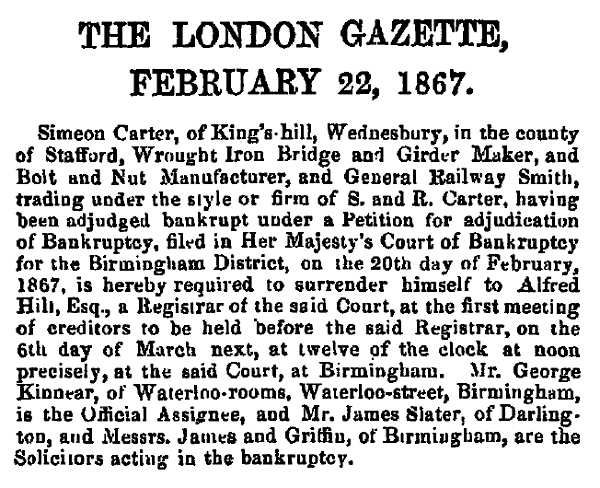
A meeting of the creditors was held in James Slater's
office on 6th March, 1867, during which most of those present
agreed to accept his offer, and take no further action. As a
result he was discharged from bankruptcy on 15th May,
1867, and made the final payment to his creditors in July
1868.
On 15th June, 1867 an advert appeared in the Birmingham
Gazette for the sale at auction of King's Hill
Works. It includes a list of the workshops, and plant, and
gives a good impression of the layout of the site:
| Important and Extensive Freehold
Ironworks at King's Hill, Darlaston, and
Freehold building land adjoining the station
and Cobden Street, Fallings Heath.
As a whole it forms one of the best works
in the district, being substantially built,
well arranged, and admirably situated, being
bounded by the railway, into which there is
a siding, thereby affording direct
communication to all parts of the kingdom.
Lot 1. A small and compact
freehold ironworks
situate at King’s Hill, Darlaston, with good Dwelling House and Outoffices, Forging Shop, Screwing Shop, Warehouse, Smith’s Shop,
Engine House, and other erections, with good yard, approached from
the street.
Lot 2. Another desirable, small
freehold ironworks adjoining lot 1, also with Dwelling House attached, large
Forging, Smiths’ and other Shops and Sheds, Steel warehouse, etc.,
and a spacious Yard and Gateway Entrance from the street.
Lot 3. The extensive and Commanding Girder
Works at King’s Hill, with capital Fitting Shop, lofty Stack, iron
Erection Shed, and other sheds, good Offices, and upwards of an acre
of Freehold land, possessing a large frontage to the street.
Lot 4. An important and improving lot of
freehold building land, having a frontage to the Wednesbury Turnpike
Road and to an intended new road, bounded on one side by the South
Staffordshire Railway; adjoining the Darlaston Station, now ripe for
building purposes, the whole containing an area of 10,000 square
yards. The entire property will be first offered as one lot, and, if
not sold, in the foregoing ones. As a whole it forms one of the best
works in the district, being substantially built, well arranged, and
admirably situated, being bounded by the Railway, into which there
is a siding, thereby affording direct communication to all parts of
the kingdom.
Machinery. The undermentioned
articles, forming part of
the valuable machinery, now in the premises, may be taken to at a
valuation by the various purchasers of the different lots, at their
option, and should they decline to do so, the same will be sold by
auction, on the
premises, on Wednesday 26th inst.
On Lot 1. Fifteen double and
single Screwing Machines, the majority with bevel reversing gear,
one Headstock with mandrill and cutters, and lever for rounding;
about 125 ft. of shafting, with couplings, carriages and pullies
complete; Heating Furnace and Stack, seventeen horsepower Steam
Engine, all complete; Punching Machine, Shearing and Punching
Machine, iron-plate Girder and Blast Culverts etc.
On Lot 2. Blast Culverts.
On Lot 3. Two Steam Boilers and Fittings, of
twenty and twelve horsepower, grating, flues etc. complete; ten
horsepower Vertical Steam Engine; range of 2in. Shafting, etc.; and
iron Lattice Girder, three large Punching and Shearing machines,
three horsepower Steam Engine, and powerful Lever Punching and
Shearing Machines etc., complete; two heating Furnaces and stacks,
five horsepower Steam Engine, complete; and about 51 ft. of Shafting
etc., large self-acting Planing Machine, steam pipes and cocks, Blast
Culverts, and Railway.
On Lot 4. The Railway
Lot 5. An improving
Plot of freehold building land, having a frontage of twenty seven
yards to Cobden Street, Fallings Heath, Darlaston, containing in the
whole 1,971 square yards.
Lot 6. Another Plot of freehold
building land, having a frontage of 29 yards to Cobden Street, Fallings
Heath, Darlaston, and containing 1,701 square yards.
For
lithographic plans and particulars apply to Messrs Harding and sons,
Solicitors, Waterloo Street, or the Auctioneers, Temple Row,
Birmingham.
|
|
As can be seen from the above description, the factory in
its final form covered quite a large area. The auction was
held at The Castle Hotel in Pinfold Street, on Monday 24th June,
1867 at 5 p.m. followed by a second auction at the site, on
Wednesday 26th June. The site was acquired by the
Staffordshire Tramways Company Limited for the building of
the Darlaston Tram Depot which opened in 1883. |
|

The advert for the sale of the tram
depot in 1927 also includes the dimensions of the site.
|
| The site is now occupied by York Crescent. Simeon died
in Tipton in 1890 at the age of 72. He was buried near his
wife, his mother and his parents-in-law in the burial ground
behind Pinfold Street Chapel. Two of his children were also
buried there. |
| I have to thank Peter Carter, who supplied much of the
information. He has extensively researched his family and
their various business ventures. |
 |
Return to
the
previous page |
|